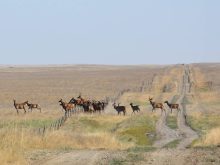Dry soil, wet conditions and delayed harvest are the reasons behind the potential yield decline across Prairies
While official numbers have yet to be released, some crop specialists are expecting that winter wheat acreage will either be down or hold steady this year.
Concerns over seeding into dry soil, abnormally wet conditions and harvest delays are the main reasons for possible acreage decline.
In Alberta, crop specialist Mark Cutts said the delay in harvest throughout the province has likely caused many farmers to not seed winter wheat.
“Winter wheat acres will be down because there is a significant amount of crop still out there,” said Cutts, who is with Alberta Agriculture. “We’re also past that seeding window. There won’t be any more opportunities given the fact we’re in the middle of October.”
Read Also

Crop quality looks good this year across Prairies
Crop quality looks real good this year, with the exception of durum.
Of the three prairie provinces, Alberta has been the most delayed in harvest this year because of unfavourable weather. The latest provincial crop report pegs the provincial harvest as being 40 percent complete, which is well behind the five-year average of 82 percent.
In Saskatchewan, where producers up north are also facing delays, crop specialists aren’t sure if there will be a decline in winter wheat acres. It could hold steady.
“Acreage will be location dependent,” said Amanda Swanson, an agronomist in Moose Jaw with the Western Winter Wheat Initiative.
She said in the southern part of the province, producers have been concerned with soil moisture due to prolonged dry conditions. In the north, lots of moisture and harvest delays might have made it difficult for farmers to find time or suitable stubble for seeding.
“We’re probably holding steady or be similar to last year, but we will see,” Swanson said.
In Manitoba, agronomist Ken Gross said he expects acres to remain the same in his province, but can’t say for sure.
He said some farmers there have experienced wet conditions for the last while, which has made seeding tricky in some areas. However, people who managed to seed are seeing good growth so far.
“I think we will hopefully be around the same acres, but that’s just my guess. It’s hard to get a handle on it right now,” said Gross, who is also with the Western Winter Wheat Initiative and located in Brandon.
The actual acreage numbers are expected to be released by Statistics Canada soon. In the fall of 2017, 535,000 acres of winter wheat were seeded across the Prairies, a 12 percent decrease from 609,000 acres in 2016.















